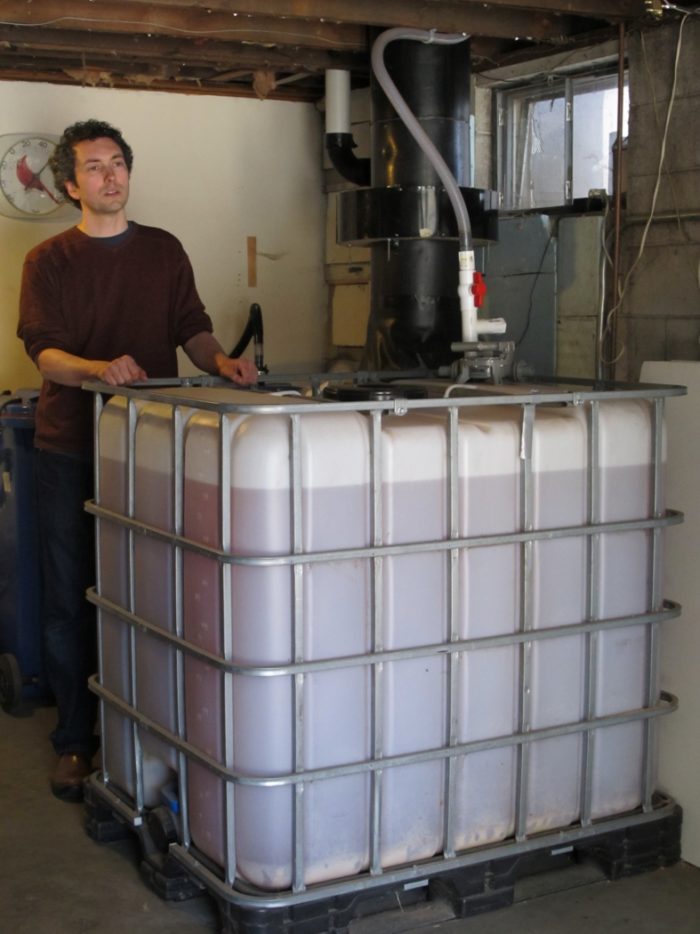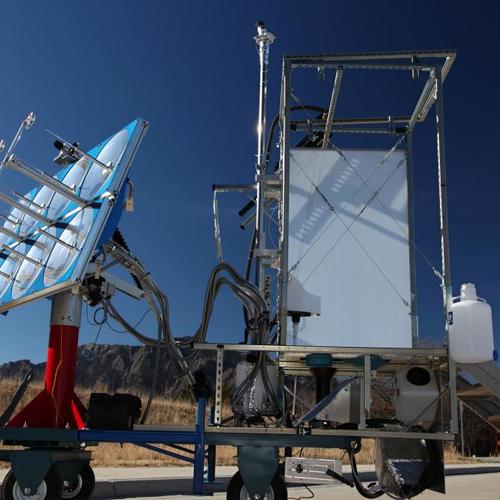
Image Credit: Alex Wilson
Image Credit: Alex Wilson Urine-separating composting toilet.
Image Credit: Alex Wilson Urine transfer pump to transfer from 5-gallon containers to larger storage bins.
Image Credit: Abe Noe-Hays Spreading diluted urine on hay field.
Image Credit: Abe Noe-Hays Test plots showing strips fertilized with urine (darker green).
Image Credit: Abe Noe-Hays Nutrients in human waste. Note that the dry mass of urine is actually greater than that of feces and that nitrogen and phosphorous levels in urine significantly exceed those of feces. Source: Swedish data from the Rich Earth Institute.
Image Credit: Rich Earth Institute
Just when you thought it was safe to enjoy this blog over your morning cup of coffee, here’s an article on… urine?
Really?
Let me explain.
Urine is a largely sterile, nutrient-rich resource that can be used in fertilizing plants. In fact, according to the Rich Earth Institute, the urine from one adult in a year can produce over 300 pounds of wheat — enough for nearly a loaf of bread per day.
The Rich Earth Institute is a Brattleboro-based organization that’s at the leading edge of this little-known practice of urine collection and use — something that’s emerging in Sweden and a few other places. This past Friday night roughly 200 people gathered at the Strolling of the Heifers’ River Garden in downtown Brattleboro to hear Abe Noe-Hays and Kim Nace from the Rich Earth Institute, along with a New York City comedian/activist, Shawn Shafner, discuss the idea.
I thought I should weigh in and describe some of the benefits — both from an energy and nutrient-flow standpoint.
Conventional practice
With conventional practice, human waste (urine and fecal matter) is mixed with large quantities of potable water and flushed down toilets. From there, it typically flows to municipal wastewater treatment plants where energy- and chemical-intensive processes use bacteria to break down organic wastes, separate out biosolids, kill pathogens, and release that water into rivers or aquifers.
Or, if we live in rural areas not served by a municipal sewer system, that wastewater flows into septic tanks where solids settle out and the effluent then flows into the soil through leach fields — in most cases with most of the nutrients in that waste filtering down into the underground aquifers. I learned when researching on-site wastewater disposal years ago for an article in Environmental Building News that the aquifers under rural New England towns almost always have nitrate levels that significantly exceed federal drinking water standards.
At the same time, in the chemical industry, tremendous quantities of natural gas are used in the Haber-Bosch process (invented in 1915) to extract nitrogen from the atmosphere, which is made up of roughly 78% nitrogen gas (N2), to produce ammonia fertilizer, the mainstay of commercial agriculture.
Utilizing human urine
When most people think of creating fertilizer from animal waste, they think of manure. Composted cow manure, for example, is widely sold in garden centers. But there are actually far more nutrients in urine than in fecal matter.
In human waste, 88% of the nitrogen is contained in the urine, along with 66% of the phosphorous, according to Swedish research (see table at end of blog), while nearly all of the hazards — including bacterial pathogens — are contained in the fecal matter.
The idea that the Rich Earth Institute has been advancing for the past several years is to collect human urine, sanitize that urine to kill any bacteria that may be in it (from urinary tract infections, for example, or fecal contamination), and then apply it on fields as a fertilizer.
Abe Noe-Hays, who used to work for our company, BuildingGreen, has been leading the charge with this idea in the U.S. The Rich Earth Institute secured funding from the U.S. Department of Agriculture, through the Sustainable Agriculture Research and Education (SARE) program to study urine collection and use as fertilizer, and the Institute is into its second year of this study.
Collecting urine
Specialized urine-separating flush toilets are available in Scandinavian countries with front chambers for capturing urine. Abe Noe-Hays manufacturers a urine-separating composting toilet, and the Institute provides special toilet insets for urine collection. On a larger scale, collection of urine from men’s rooms that have waterless urinals is very easy.
With the help of Best Septic Service in Brattleboro, the Institute collected 3,000 gallons of urine from over 170 participants in 2013.
Sterilization
According to most experts, simply storing urine for a while in a sealed container is enough to kill bacteria, due to the high alkalinity and ammonia from the urine. But the Rich Earth Institute is experimenting with faster pasteurization systems that heat the urine (including with solar systems that circulate solar-heated fluid through heat exchangers in the urine tanks).
They are also testing various strategies for controlling odor — likely the biggest hurdle we face with urine collection and use.
Land application
In Sweden urine is being applied on food crops, but to date, with USDA support and permits from the State of Vermont, the Rich Earth Institute has stuck with less controversial applications on non-food crops — specifically hay fields.
Initial results last year with undiluted urine and dilution rates of 1:1 and 3:1, dramatic improvement in hay production was seen (see photo).
Because urine may contain pharmaceuticals, there is an important question about whether that poses a problem. This year, the Institute will begin an EPA-funded study to test whether residual pharmaceuticals in urine are taken up by vegetables grown on experimental plots.
It’s better than letting the nutrients evaporate
I have long been a fan of composting toilets. I like the idea of not mixing human waste with potable water, and I’ve always felt that flushing away the nutrients in human waste was a lost opportunity. But when I learned about urine separation and use (believe it or not in a luncheon presentation on the topic at a conference in Houston, Texas in 2009), I began to see the benefits of urine separation over standard composting toilets.
With standard composting toilets, most of the nitrogen in the waste ends up being volatilized as either nitrogen gas or ammonia — and lost into the atmosphere. With urine collection and use, the nutrients aren’t lost; they are recycled in a sustainable nutrient cycle.
This is something we’re considering for Leonard Farm, though we have not installed such a system yet. For more information or to participate in ongoing studies, contact the Rich Earth Institute.
Alex is founder of BuildingGreen, Inc. and executive editor of Environmental Building News. In 2012 he founded the Resilient Design Institute. To keep up with Alex’s latest articles and musings, you can sign up for his Twitter feed.
Weekly Newsletter
Get building science and energy efficiency advice, plus special offers, in your inbox.












2 Comments
Alex: A lesser known fact...
Alex,
A lesser known fact about industrial waste disposal practices in western nuclear nations with uranium conversion and reactor fuel making facilities, is that the uranium-rich ammonia (tails) is diverted (very quietly) into the commercial fertilizer production stream.
It is a sensible concept to capture the urine's nitrogen for fertilizer production provided it is processed to remove contaminants (i.e hormones and other pharmaceuticals). To be commercial, how would the pee-gate to processing plant infrastructure be set up?
I am curious, is there not a displeasing odor in water-free toilets? There sure is in low-flush, broken and manual-flush urinals.
A significant hitch with putting any human waste (urine or faeces) directly into the agriculture production cycles is that at least 1/4 of the world's population is prohibited by religious law from physical contact with these substances and that includes a prohibition from recycling them directly into the food chain.
Also about 1/3 (or more) of the world's population uses potable water to wash their genitals and their backsides when using the toilet for urination and or defecation. They are required by religious law and cultural convention to wash (including after urination) and not to smear with paper or free-drip into their underwear.
Another move towards updating Vt state waste water rules
Great article Alex, Thanks for that.
We are planning a development here in Northern Vermont where we want to apply the use of composting toilets and urine collection as a means of decreasing the size of the septic system. As you know, on small plots in village centers, where many towns are trying to encourage development, the septic system design and the space it requires often cuts down on the possible number of dwellings a plot can sustain.
The State already has rules for decreasing the size of the septic system by 25% through the use of composting toilets, however the urine and gray water issues still require quite a large system.
Very much looking forward to following the developments in this corner of the green housing industry. Let's take our wastes, after careful consideration of what we put in ourselves (like pharmaceuticals), and turn them into fertilizer for our gardens.
Good work Rich Earth Institutue!
Log in or create an account to post a comment.
Sign up Log in